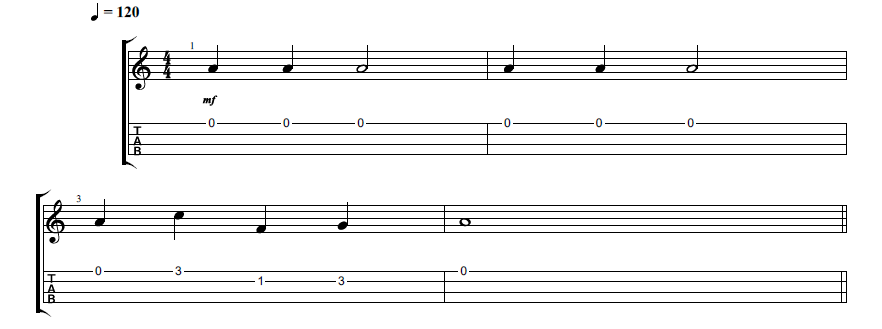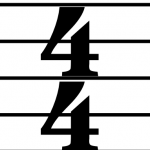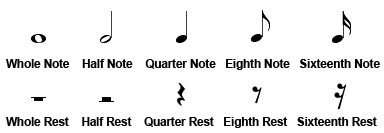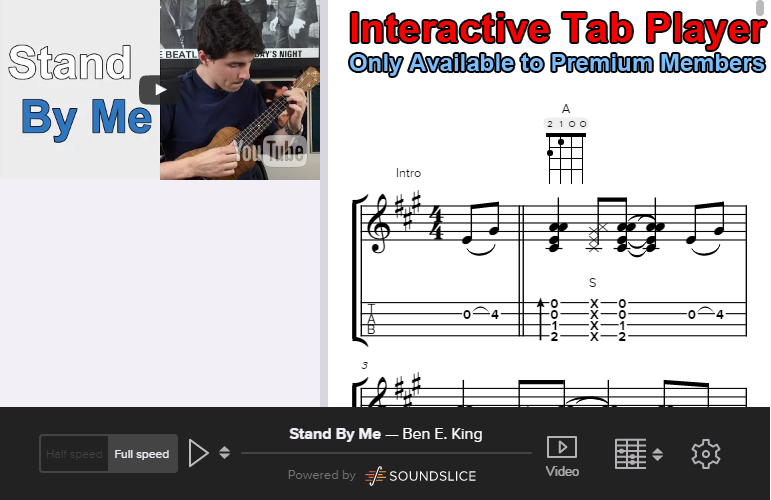Understanding Rhythmic Notation on Ukulele
Lesson Video Featuring 11 Exercises
Tab Play Along for 11 Exercises
Ukulele Tablature

Take a look at the above. Try and play through the notes. Can you tell what song it is?
The biggest issue with tablature is the lack of information it provides. The tab above tells us nothing about the duration (rhythmic value) of the notes. Now, if I was to tell you the above song is "Jingle Bells", we can all play through it without needing to see standard notation (those dots!) as the melodic rhythm is familiar to our ear. But, what if we are playing a song that isn't so simple or easy. This is where understanding rhythmic values becomes necessary.
What Are All Those Dots?

Now, take a look at the above. With a thorough understanding of rhythmic notation, we could perform the piece above without being told it is "Jingle Bells". Pretty cool, right? So, how do we get to this point?
Time Signatures, Note Values, & Rest Values
4/4 Time Signature
Our time signature in Western music is expressed as a fraction. The top number tells us how many beats (to count) per measure. The bottom number tells us what kind of note to count. In other words, the bottom number corresponds to note values:
2 = half note
4 = quarter note
8 = eighth note
4 / 4 (also known as common time) tells us to count 4 (top number) quarter notes (bottom number) per measure. Thus, we would count the beat as: 1, 2, 3, 4 (per measure, than start over for the next measure). All the notes in each bar must add up to 4 quarter notes. It doesn't matter what combination of rhythms are used, as long as it adds up to 4 quarter notes.

Whole Notes
A whole note lasts for 4 beats. Whole notes are hollow ovals without a stem.
We can count whole notes as: 1 2 3 4. This means to hit on the 1 beat and hold it for the remainder of the count.


Half Notes
A half note lasts for 2 beats. Half notes are hollow with a stem (line sticking out from the note head).
Half notes can be counted: 1 2 3 4. Thus, we would hit on beats 1 and 3 as shown below.


Quarter Notes
A quarter note lasts for one beat. Quarter notes always are filled in (solid black dot) with a stem.
We can count quarter notes as: 1 2 3 4.


Eighth Notes
Eighth notes last for half a beat. They resemble quarter notes, but have a flag attached to the stem. Beams, a thick horizontal line used in place of flags, connect groups of two or more notes to form a metrical unit (a fancy way to say: a beat). Notice how the beam in the picture connects two eighth notes. Beamed groups are much easier to read than a cluster of flagged notes.
Eighth notes are counted: 1 & 2 & 3 & 4 &.


Sixteenth Notes
We can further subdivide the beat to create sixteenth notes. A sixteenth note is half of an eighth note. This is represented by 2 flags attached to the stem (single note) or 2 beams for multiple groups of notes.
Sixteenth notes are counted: 1 e & a, 2 e & a, 3 e & a, 4 e & a.


Eighth Note Triplets
Triplets are a group of three notes that occur in the amount of time that two notes of the same value are usually played. In other words, if we had 1 bar of eighth notes (8 notes), we could subdivide the beat into 3 equal parts by using eighth note triplets (as shown below). Triplets are always grouped in 3 and have the number "3" displayed above the group.

Triplets can be counted: 1, 2, 3 or Trip-l-et.


Rests
Likewise, rests are counted just like the equivalent note value.

What To Take Away From This Lesson
Moving beyond "feeling the beat" to being able to count and understand rhythm is vital to growing as a musician. Not only does it take the mystery away, but it helps to improve your timing and rhythmic ability. I would highly recommend to use a metronome when working on the 11 exercises provided in the lesson video PDF. Try to tap your foot along to the metronome and count aloud (not only in your head). Start slow and gradually increase the tempo. Counting, tapping, and playing at the same time is tough! Keep at it everyday and you will be amazed by how quick you start to get the hang of playing multiple rhythms in perfect timing!
Article by: Andrew Hardel

